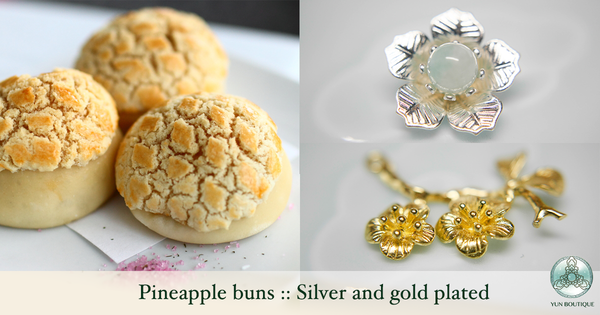8% off orders over $100, 15% off orders over $150, 20% off orders over $300.
Menu
-
- Specials
-
Types
-
Symbols
- Auspicious Cloud | Heaven
- Lotus | Purity & Elevation
- Phoenix | Rebirth and Fidelity
- The Nine | Eternity and Completeness
- Bamboo | Strength and Resilience
- Ruyi | Wish Fulfillment
- Moon | Mystery & Elegance
- Herbal Locket | Hidden Protection
- Tassel | Elegant Charm
- Butterfly and Flower | Love
- Plum Blossom | Endurance and Resilience
- Chinese Knot | Harmony, Tradition, Legacy
- Pumpkin | Prosperity & Abundance
- Pipa | Celestial Music
- Hulu Gourd | Protection and Prosperity
- Fish | Prosperity
-
Collections
- Atlantis
- Revive Your Inner Kingdom
- Auspicious Origin
- Auspicious Flower
- Udumbara Flower
- Return to Origin
- Celestial Cloud
- Elf Forest
- Gold Lotus
- Serene Lotus
- Pearl Elegance
- Radiance
- Metropolis Hermit
- The Nine
- Moon Goddess
- Tassel Elegance
- Chic Velvet Choker
- The Cloud
- Lotus Leaf
- Realm of Peace
- Four Season
-
Craftsmanship
-
Gemstones
- Pearl | Purity and Wisdom
- Jade | Stone of Heaven
- Turquoise | Protection and Healing
- Tridacna | Realm of Peace
- Lapis | Truth and Enlightenment
- Rose Quartz|Love, Healing, Compassion
- Amethyst | Clarity and Tranquility
- Amber | Vitality and Protection
- Carnelian | Courage and Vitality
- Coral | Protection and Prosperity
- Tourmaline | Energy and Balance
- Crystal | Healing and Clarity
-
Birthstone
-
Style
-
Price
-
- Jewelry Set
- Necklaces
- Earrings
- Bracelets
- Hair Jewelry
- Glasses Chains
- Rings
- Anklets
- Ornaments
- Login
-
English

8% off orders over $100, 15% off orders over $150, 20% off orders over $300.
Types Of Jewelry Metals, As Explained By Chinese Desserts
December 21, 2015 3 min read

People can make jewelry out of anything, from 3D-printed plastic to cut-up vinyl records. But metal jewelry will always be around, so it’s worth knowing about the metals your jewelry is made of.
This can be a rather dry subject, so we’re sweetening the deal by explaining them through Chinese desserts. Once you’ve read this post, you’ll approach the jewelry counter (and the bakery) with confidence.

Base Metal
Base metal is typically a cheap metal like copper, brass, aluminum, bronze, or nickel. Nickel is the #1 cause of metal allergies, and people with sensitive skin react to nickel when it is mixed in metal alloys. Lead, as another metal element, is another no-no for obvious reasons.
Chinese dessert twin: White sugar cake is probably the cheapest Chinese dessert you can find. It’s simply a mixture (an alloy, if you will) of rice powder, sugar, and a lot of air.

Gold And Silver Plated
Gold and silver plated metals are a base metal plated with a barely-there layer of gold or silver. Plating refers to a chemical or electrical process that makes a thin layer of the plating metal to adhere to the main metal. Usually the plating wears off quickly, revealing the metal underneath, which is usually different color.
Chinese dessert twin: Pineapple bun, which is just plain bread baked with a helmet of sweet yellow crust (incidentally, containing no pineapple). I pick off the yummy crust and lose interest in the rest.

Gold- And Silver-Filled
This is a step above plated metal, and is usually pretty sturdy. Filled metals are essentially two layers of metals bonded together—a layer of gold over a layer of base metal. Sometimes you can see 10K gold-filled, 14K gold-filled, etc. stamped on the metal. K (meaning karat) denotes purity of the gold. 24K is the purest. In the Yun Boutique shop, we tend to use 14K gold filled, which is hypoallergenic and affordable.
Chinese dessert twin: Mooncake, which is a layer of dough filled with lotus seed paste. This isn’t a perfect analogy because the filled metal as a “skin” is, relative to the base, thicker than the skin of the mooncake.

Gold Vermeil
Gold vermeil can be thought of as a premium version of gold plating, but instead of putting gold over a base metal, the gold is bonded to sterling silver or fine silver. It costs more, and is considered safer in case the gold wears off.
Chinese dessert twin: Really fancy mooncake.

Sterling Silver
Sterling silver contains 92.5% pure silver; the rest is usually copper to make the metal hard enough to work into jewelry. All silver tarnishes, though there exists Argentium sterling silver, which tarnishes slower. Sterling silver, because it contains barely any other metals, is considered hypoallergenic for most people.
Chinese dessert twin: In terms of material composition, almond jello would be sterling silver's twin. It’s mostly gelatin, with just a smidgen of almond flavoring to make it worth your time.

Fine Silver AKA Pure Silver
This is .999% pure silver, but is hardly ever used in jewelry because pure silver is too soft to hold shape.
Chinese dessert twin: Dragon's beard candy, also known as Chinese cotton candy, fits the bill. It is almost pure sugar, and is so rare, you've likely never heard of it, much less eaten it.

Solid Gold
Gold is measured in karats, with 24K being the purest, and by nature, most malleable. Other karat weights range from 10K to 22K. While we think of gold as yellow in color, white golds and rose golds can be created through alloys.
Chinese dessert twin: Bird’s nest, which is expensive but not too rare nowadays. It used to be exclusive to royalty, but now this delicacy can be found at most upscale Chinese supermarkets.
Produced and edited by Christine Lin.
Leave a comment
Subscribe
Sign up to get the latest on sales, new releases and more …

